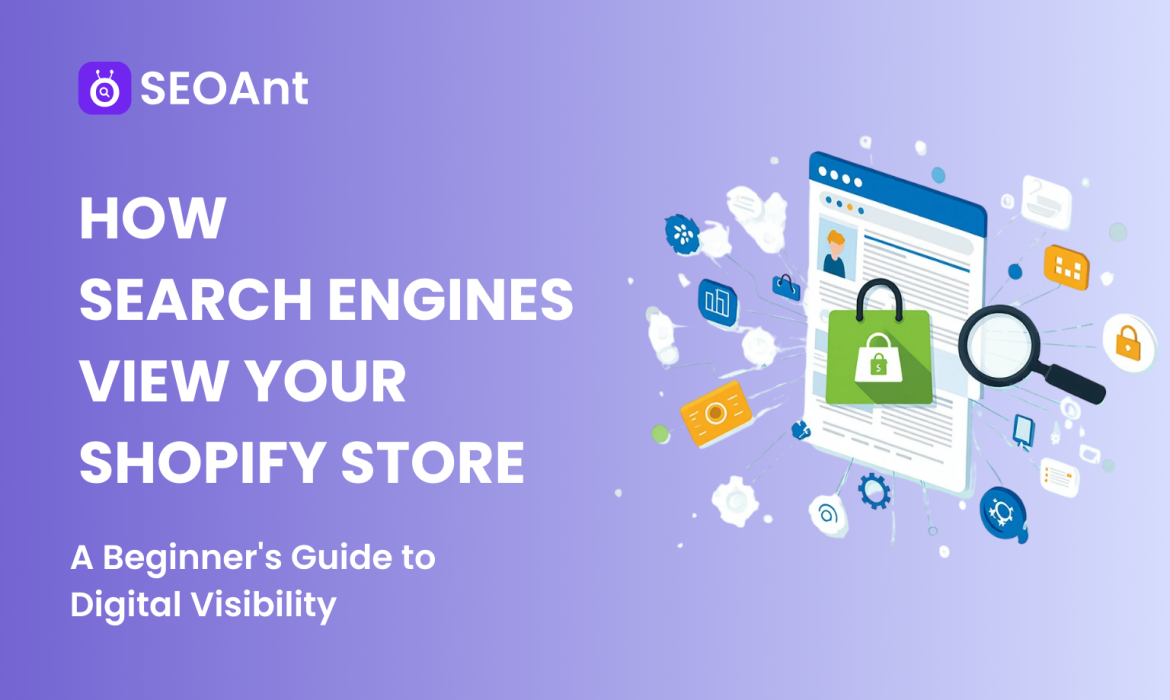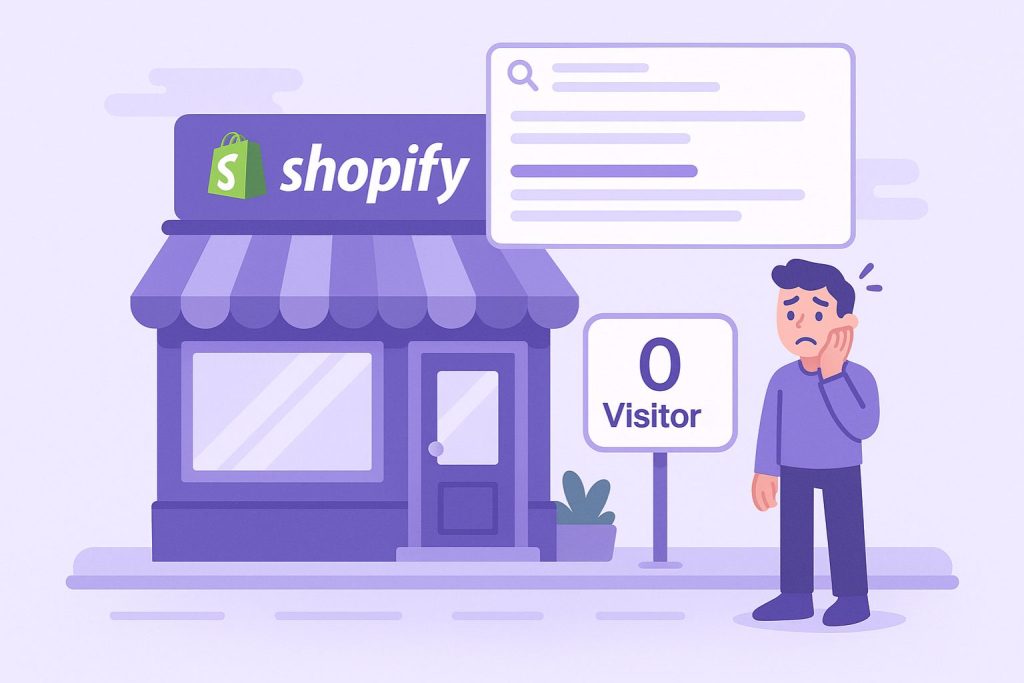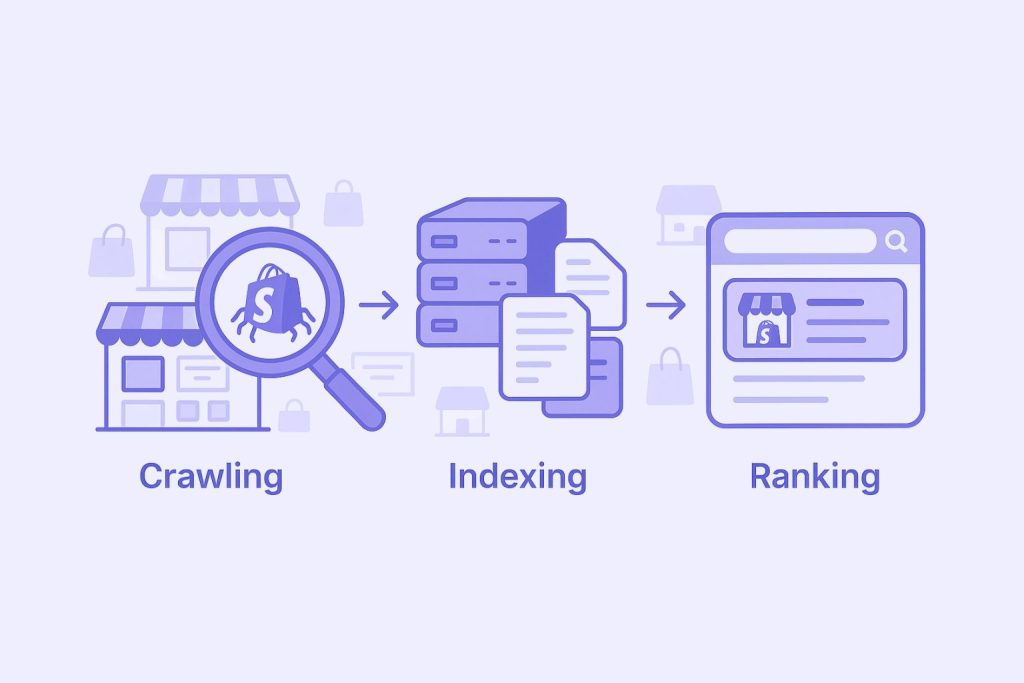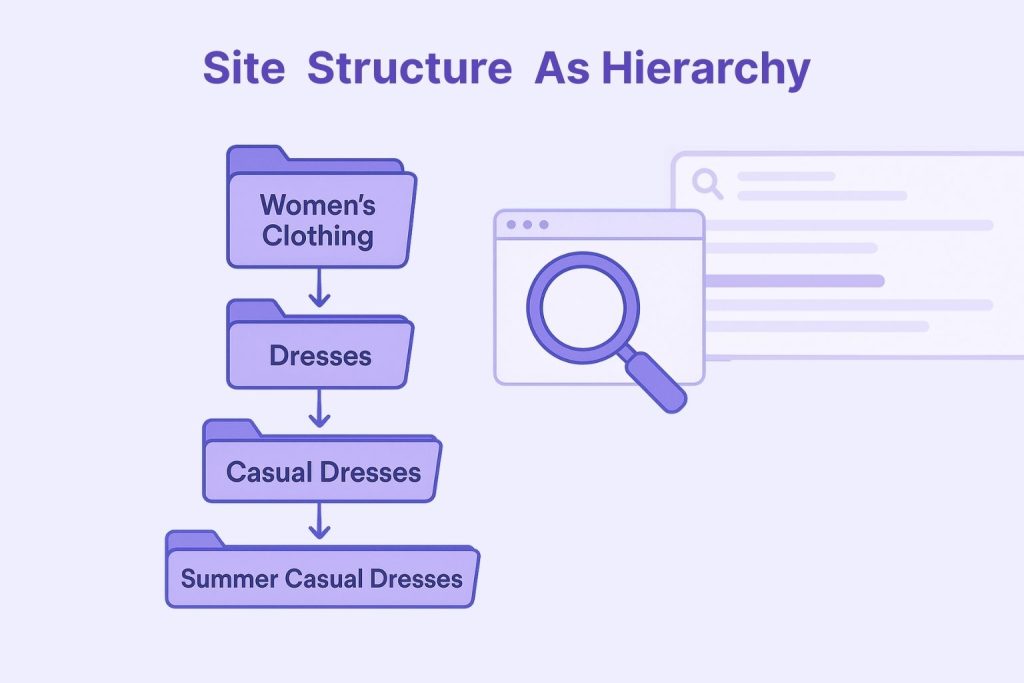
Table of Contents
The Invisible Store Problem Every Shopify Owner Faces
Imagine this: after dedicating weeks to meticulously building your Shopify store, carefully selecting products, designing great product layouts, and crafting compelling product descriptions, you launch your store with enthusiasm, expecting customers to discover your amazing products! Then, cricket sounds. Your analytics demonstrate that most traffic comes from you, and your organic search traffic registers as single digits. If so far this sounds familiar, you are not alone! New Shopify store owners often see fewer than 100 organic visitors within 2-3 months of launching their store, not because there is no demand for their products, but simply because the search engines do not know how to organize and market their stores to prospective customers due to lacking of strategic Shopify Store SEO.

Here is the truth: search engines like Google are processing over 8.5 billion searches every single day, and most Shopify store owners are completely invisible in these very relevant, very valuable search results. The difference between a store that is successful, and a store that struggles, is not because successful stores have better products or prices, the difference is understanding the context in which search engines use to define and categorize shopify store content, and then prioritize relevant store content.
In this easy-to-follow Shopify SEO guide you will learn exactly how search engines find, evaluate, and rank your Shopify store. More importantly, you will be introduced to practical ideas that will change your Shopify store from being invisible to discoverable, and then attract qualified customers to your store, as a natural process. This Shopify SEO for beginners journey focuses on understanding what is technically required, rather than worrying about how much time and effort it would take to set-up.
Understanding How Search Engines Discover and Evaluate Your Shopify Store
Think of Search Engines as Digital Librarians
To understand search engine optimization shopify success, think of search engines as very effective digital librarians, keeping the best library – the world’s largest library. So, these librarians not only don’t just put books on shelves, they take into account cataloging (organizing), helping you find the books you need, and recommending the best resources for you.
When you walk into the library and ask the librarian (search engine) where the “comfortable running shoes for flat feet” are: the librarian must quickly find the most helpful, legitimate and useful information – after all, there are millions of books to search from. When you think of your Shopify store as just one book in that library, consider how well the librarian understands your book (your store, it’s purpose) and uses their resources (knowledge and experience) to categorize your book.
Think of it this way: when librarians are referencing books as a resource (and assuming they are a competent, responsible librarian), they are referencing the content quality of the book (what’s inside), the authors credibility (who is behind it) and reader usefulness (would this useful for a reader that asks: “where are the comfortable running shoes for flat feet”.).
Similarly: search engines look at the quality of your product description, your reputation (the business), and your satisfaction, to determine how, when and how much to recommend to their users.
Understanding this perspective is really important for Shopify SEO for beginners, as the thought process shifts from “gaming algorithms” to genuinely useful value that search engines can quickly understand and can confidently refer their users to.
The Three-Step Discovery Process: Crawling, Indexing, and Ranking
Search engines evaluate your Shopify store through a three-step process: crawling, indexing, and ranking. Each stage plays a critical role in how easily customers can discover your products online. Understanding search engine crawling requires grasping three distinct phases that determine your store’s visibility. Each phase presents unique opportunities and challenges for Shopify store owners.

| Step | What It Is | How It Works | Why It Matters for Shopify Stores |
| Crawling: The Digital Store Visit | Search engines send automated programs (crawlers/spiders) to explore your store. | Crawlers follow links from homepage to product pages, collections, blogs, etc., checking site structure, load times, and navigation. | A clear site architecture ensures all pages are discoverable. Broken links or confusing navigation can block crawlers, leaving pages unseen. |
| Indexing: Building Your Store’s Digital Profile | Search engines store and organize information about your pages in their databases. | Unique, descriptive content helps search engines understand what each page offers and how it fits into your store. | Poor indexing (due to duplicate or thin content) reduces visibility. Shopify’s technical SEO setup plays a key role in accurate categorization. |
| Ranking: The Recommendation Algorithm | Search engines decide when and where your store appears in results. | They weigh hundreds of factors like relevance, authority, speed, mobile optimization, reviews, and business credibility. | Stores that focus on user experience, quality content, and trust signals rank higher and attract more targeted traffic. |
What Search Engines Actually See When They Visit Your Store
Site Structure: Your Store’s Blueprint
When the search engines analyze shopify site structure they are basically examining your store’s blueprint and understanding how the content pieces relate to each other and also how the content flows logically. This is as important as anything else because it literally impacts how well search engines can associate your products to customer searches.
Search engines prefer logical, hierarchical structures that can identify with users thinking. For example, a clothing store might be organized like this, Women’s Clothing →Dresses → Casual Dresses → Summer Casual Dresses. This provides a lot of context to the search engines and they know exactly what the page is about and when to show it.

Your navigation structure will provide search engines with direction just like a map. Clear category organization, detailed descriptions in the menu items and related products organized together help search engines understand the focus of your business but also how products relate to one another. If your store is all over the place and has no organization or clear navigation the search engine will be confused, which can limit search visibility.
URL structure significantly impacts shopify store search visibility because URLs provide immediate context about page content. Descriptive URLs like “/collections/organic-baby-clothes” communicate clear information, while generic URLs like “/collections/products-123” offer no helpful context for search engine understanding.
Internal linking between related products and categories strengthens site architecture by showing search engines how your content connects. Strategic linking helps distribute authority throughout your store while providing additional context about product relationships and category hierarchies.
Content Elements Search Engines Evaluate
Beyond technical structure, search engines carefully analyze the actual content that defines your store’s value proposition and customer relevance.
| Factor | What Search Engines Evaluate | Why It Matters |
| Product Information Quality | – Uniqueness, detail, and value of product descriptions – Comprehensive details (materials, dimensions, use cases, care, benefits) – Image optimization with descriptive alt text and file names | – Original, detailed descriptions outperform generic manufacturer copy – Rich content improves customer decision-making and rankings – Optimized images boost both visibility and user experience |
| Store Credibility Signals | – Complete business details (contact info, return policies, security badges) – Professional design elements- Customer reviews and testimonials – Consistency across Google My Business and other platforms | – Builds trust with customers and search engines – Authentic reviews provide strong social proof – Consistent business info helps verify legitimacy and local relevance |
| Content Freshness and Updates | – Regular updates (new products, updated descriptions, blog posts, seasonal changes) – Targeting trending keywords and seasonal search terms – Accurate inventory management and product availability | – Signals active business management and relevance – Fresh content improves rankings on trending/seasonal searches – Updated inventory prevents negative SEO impact from stale info |
Common Shopify Store SEO Misunderstandings That Limit Growth
In the pursuit of growing a Shopify store, many merchants often find themselves in common SEO traps that silently restrict their visibility. Misconceptions about how Shopify SEO really works can create a false sense of confidence while leaving a vast array of opportunities on the table. By debunking these myths, store owners can focus on the tactics that generate sustainable search growth.
Myth 1: Shopify Handles All SEO Automatically
Numerous store owners think that Shopify takes care of everything SEO related, but in fact, it limits itself only to the technical part, providing you with a lot of the technical aspects already set up for you (eg. sitemaps, mobile responsive, hosting speed, SSL etc.). Visibility in the search engine results pages is only created through the hard work of search engine optimization involved in writing product descriptions, finding keywords that fit your product range, and writing quality content. Shopify is like owning a professional camera; just because you own a professional camera doesn’t mean you’ll have great results, and we would still expect someone to use skill and strategy.
Myth 2: SEO Apps Solve Everything
Another common misconception is that adding SEO apps improves your shopify search engine visibility. While decent apps can give you useful tools or automate certain aspects of your SEO, they aren’t a substitute for a basic understanding of the principles of search engine optimization.
SEO apps usually complement manual optimization rather than replace it. Apps can do great things like bulk edit meta tags, compress images, and conduct technical audits, but they can’t create content strategies, or develop authentic customer relationships that lead to long-term success.
You should always develop a basic understanding of Shopify Store SEO and create optimization processes manually first before you install any app. Doing this ensures that your processes are founded in your basic SEO knowledge so that you can understand how any app’s processes will either add value to your business or constantly be referred to as a solution when you can use optimization processes that you have developed and structured for your specific business purposes.
Myth 3: More Products Equal Better Shopify Store SEO Performance
Store owners may believe that more products means better SEO but search engines prefer quality instead of quantity. A small catalog with optimized descriptions, keywords, images and categories will outperform a large poorly optimized store every time. Always focus on adding products strategically with care, based on research and demand, that improves growth without reducing optimzatrion practices.
Simple Changes That Improve How Search Engines See Your Store
Quick Wins You Can Implement Today
Understanding search engine optimization principles becomes actionable through specific improvements that immediately enhance how search engines perceive and categorize your Shopify store.
Basic Settings Optimization
Start with your store’s essential settings that provide search engines with the critical business context they need. In Shopify admin’s Preferences look at your store title and meta description- these appear on search results and impact your click through rate. Your title should clearly say what your business is and/or the keywords you are focused on (without being overly spammy, i.e. Sustainable Home Goods | Eco-Friendly Kitchen and Bath Products). Meta descriptions should be write as short pitches full of value with built in keywords that flow with great reasonable. Lastly, make sure your contact page is filled out with accurate information as well as your hours of operation, phone number, email and address. All of these details can help build credibility with back search engines and give added local relevance.
Product Page Quick Fixes
Review your top-selling products and identify optimization opportunities that require minimal time investment but deliver substantial impact on Shopify store SEO optimization. Product titles should balance keyword optimization with customer clarity. Include primary product keywords while maintaining natural language that customers would use when searching. “Women’s Waterproof Hiking Boots – Size 6-11” works better than “Boots Women Waterproof Hiking Outdoor Footwear.”
Evaluate product descriptions for uniqueness and detail level. If you’re using manufacturer descriptions, rewrite them to reflect your brand voice while addressing customer questions and concerns. Include specific details about materials, sizing, care instructions, and use cases that help customers make informed decisions. Add descriptive alt text to product images using natural language that describes the image content. “Woman wearing black waterproof hiking boots on mountain trail” provides better context than “hiking-boots-product-image-1” while incorporating relevant keywords organically.
Technical Health Check
Verify that your sitemap is properly submitted to Google Search Console. Navigate to search.google.com, add your store if not already added, and submit your sitemap (typically yourstore.myshopify.com/sitemap.xml). Test your store’s mobile performance using Google’s Mobile-Friendly Test tool. Since most customers browse on mobile devices, mobile optimization directly impacts search rankings and customer experience quality. Check basic page loading speed using Google PageSpeed Insights. While you may not be able to make dramatic improvements immediately, understanding your current performance establishes baseline metrics for future optimization efforts.
Building Long-term Search Success
Sustainable shopify store search visibility requires ongoing effort focused on content creation, customer engagement, and performance monitoring that builds authority over time. To build long-term SEO success, you need more than technical fixes—you need a well-rounded strategy that covers content, customer trust, and performance tracking. The table below highlights three core areas every Shopify store should prioritize for sustainable growth.
| Strategy | Key Actions | Why It Matters |
| Content Strategy Development | – Publish blogs, buying guides, and educational material – Build a content calendar aligned with seasons, product launches, and customer trends – Focus on customer pain points, product knowledge, and insights | – Attracts links and authority – Targets wider keyword clusters – Demonstrates business activity – Builds trust and long-term customer relationships |
| Customer Review Strategy | – Create processes to collect reviews from happy customers – Respond professionally to all reviews (positive or negative) – Use feedback to improve products and content targeting | – Reviews provide social proof – Enhances product page SEO with fresh content – Builds trust with customers and search engines – Reveals customer concerns for keyword and content optimization |
| Performance Metrics | – Use Google Analytics & Search Console to track organic traffic, rankings, and buying behaviors – Track competitors with SEMrush or Ahrefs to spot trends and content gaps – Focus on conversion rates from organic traffic | – Identifies what works and what doesn’t – Uncovers industry best practices – Helps refine strategies continuously – Connects SEO efforts directly to business growth |
Your Journey from Invisible to Discoverable
Having an insight into how search engines view shopify store content and architecture is the first step to developing a sustainable search visibility strategy that will foster real, qualified traffic and customer growth. The journey from invisible to discoverable is not overnight but through systematically optimizing you can create momentum, allowing for compounded, long-term growth. Ultimately, search engines merely serve customer needs by linking them to businesses that provide real value and experience. Therefore, if you prioritize customers, product quality and service quality, you will engage with the goals of the search engines while developing sustainable business success.
Start with one immediate action today: Choose your highest-priority product and spend 30 minutes optimizing its title, description, and images using the principles outlined in this guide. This single optimization will demonstrate how understanding search engine perspectives translates into practical improvements that enhance both search visibility and customer experience.
The journey from confusion to clarity in Shopify store SEO for beginners begins with understanding rather than overwhelming technical implementation. Build on this foundation by consistently applying optimization principles, monitoring performance results, and expanding your knowledge through experimentation and continuous learning. Success in search engine optimization comes from patience, consistency, and focus on long-term value creation rather than quick fixes. Start building your search visibility today, one optimization at a time, and watch your store transform from invisible to indispensable in your customers’ online shopping journeys.








